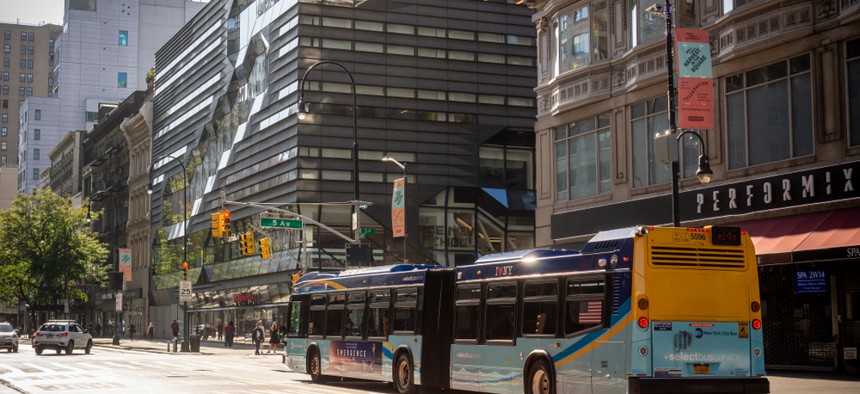Society doesn’t break down with 14th Street closed to cars
On Thursday morning, the city began its experimental transit initiative, preventing all passenger cars – including taxis and ride-hail app vehicles, such as Uber and Lyft – from driving on 14th Street in Manhattan between Third and Ninth avenues, from 6 a.m. to 10 p.m.

A bus on 14th Street in New York City rblfmr/Shutterstock
The 14th Street busway was “a nightmare set to unfold,” with West Village residents “bracing themselves for an onslaught.” When the rain-soaked day of disaster arrived … everything went pretty smoothly, actually.
On Thursday morning, the city began its experimental transit initiative, preventing all passenger cars – including taxis and ride-hail app vehicles, such as Uber and Lyft – from driving on 14th Street in Manhattan between Third and Ninth avenues, from 6 a.m. to 10 p.m.
It’s an effort to improve bus commuting times, specifically on the M14 bus line, which is among the city’s slowest – literally slower than a manatee – and has lost 30% of its passengers over the past five years. The project also seeks to reduce car emissions, and was initially introduced as a way to improve commutes for L train riders, as ongoing construction on the line promises to slow trains.
There was enormous resistance to the project, which pitted the residents of the well-to-do neighborhoods against the city’s daily bus riders. Critics insisted the initiative would increase traffic and contribute to greater noise and air pollution in the area. Several lawsuits addressing opponents’ concerns stalled the transit project – initially slated to begin in July – from going into effect, in an attempt to keep the busway from happening altogether. The project was ultimately given the green light last week.
City transit reporters and advocates have been sharing photos and updates from 14th Street on Thursday, reporting faster commute times, clear roads and enforcement of the busway’s new road regulations.
Checking in the @NYC_DOT traffic cameras to see how the 14th Street busway is going. Looks like enforcement! pic.twitter.com/NJXygJCAA6
— Kate Hinds (@katehinds) October 3, 2019
One M14 bus rider, Shannon Sweeney who lives on 7th ave and 14th street says “it’s faster than walking, and that’s not usually the case.”
— Just your friendly neighborhood transit reporter (@s_nessen) October 3, 2019
9th to 1st took 14 minutes on an M14 headed east
— Good Idea Dave (@DaveCoIon) October 3, 2019
Looks like the 14 St #BusWay is keeping Union Sq clear for buses & ambulettes, plus providing a safer environment for pedestrians.
— Maximillian (@MaxSholl) October 3, 2019
Another added benefit is the 4 Av #bikenyc has an extra half block of parking protection!
23 St sure could use some help (& Houston, 34, 42, 57...) pic.twitter.com/s3Xgoaf8Jo
Ahhhh, that clear #Busway feeling! And with that, I am ON TIME to work for possibly the first time ever when taking the M14. pic.twitter.com/w9rmuS529S
— madamwestbikes (@madamwestbikes) October 3, 2019
Reporters also shared photos from some of the surrounding streets, which critics warned would be packed if cars were forced off 14th, showing fairly normal-looking traffic flow.
Fears of side streets overrun with spillover traffic? 15th street looks fine. pic.twitter.com/ZhKtJvreLs
— Just your friendly neighborhood transit reporter (@s_nessen) October 3, 2019
A little more traffic between 3rd and 4th, but most of it was due to this single cab which didn’t move for almost the entirety of Sharon Van Etten’s “No One’s Easy To Love.” Yeah whatever I’m doing fine in life pic.twitter.com/rw0w1GiVv0
— Good Idea Dave (@DaveCoIon) October 3, 2019
Not everyone is on board with the new regulations, and some drivers are simply not yet up to speed on the new rules, but thankfully, drivers are being granted a 60-day grace period before the city begins issuing tickets for driving on the road.
The busway will be in effect for 18 months. Only time will tell whether it will continue to improve commutes and make streets safe for pedestrians and cyclists, but it’s certainly off to a smooth start.

